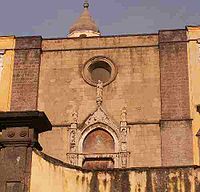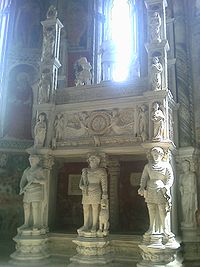
San Giovanni a Carbonara
Encyclopedia


Naples
Naples is a city in Southern Italy, situated on the country's west coast by the Gulf of Naples. Lying between two notable volcanic regions, Mount Vesuvius and the Phlegraean Fields, it is the capital of the region of Campania and of the province of Naples...
, southern Italy
Italy
Italy , officially the Italian Republic languages]] under the European Charter for Regional or Minority Languages. In each of these, Italy's official name is as follows:;;;;;;;;), is a unitary parliamentary republic in South-Central Europe. To the north it borders France, Switzerland, Austria and...
. It is located at the northern end of via Carbonara, just outside what used to be the eastern wall of the old city. The name carbonara (meaning "coal-carrier") was given to this site allocated for the collection and burning of refuse outside the city walls in the Middle Ages.
Overview
The monastery/church complex of San Giovanni was founded by the AugustiniansAugustinians
The term Augustinians, named after Saint Augustine of Hippo , applies to two separate and unrelated types of Catholic religious orders:...
in 1343. The church was completed in the early 15th century under King Ladislaus of Durazzo, who turned the church into a Pantheon
Pantheon, Rome
The Pantheon ,Rarely Pantheum. This appears in Pliny's Natural History in describing this edifice: Agrippae Pantheum decoravit Diogenes Atheniensis; in columnis templi eius Caryatides probantur inter pauca operum, sicut in fastigio posita signa, sed propter altitudinem loci minus celebrata.from ,...
-like tribute to the last of the Angevin
House of Anjou
The Angevins, also known as the House of Anjou, were a noble family founded in the early years of the Carolingian Empire. They first emerged as part of the minor feudal nobility, in what would soon be known as the Kingdom of France during the 10th century...
rulers of Naples.
It was expanded over the course of the following three centuries and contains sculptures and artwork of considerable interest, including Ladislaus' tomb order by his daughter Queen Joan II
Joan II of Naples
Joan II was Queen of Naples from 1414 to her death, upon which the senior Angevin line of Naples became extinct. As a mere formality, she used the title of Queen of Jerusalem, Sicily, and Hungary....
to Andrea Ciccione
Andrea Ciccione
Andrea Ciccione , also known as Andrea di Onofrio, Nofri, and da Firenze, was an Italian architect and sculptor of the Renaissance. He was born and died in Florence, but spent much of his career in Naples....
, the 15th century chapels of Caracciolo
Caracciolo
Caracciolo is the surname of a famous noble family of southern Italy.Its members include:*Battistello Caracciolo, Italian painter*Carmine Nicolao Caracciolo, Spanish viceroy of Peru*Francesco Caracciolo, Neapolitan admiral and revolutionist...
del Sole, with notable frescoes by Perinetto da Benevento and Leonardo da Besozzo, also housing the noteworthy sepulchre of Sergianni Caracciolo also by Ciccione, and Caracciolo di Vico (1516), the Miroballo, di Somma and Seripando Chapels, the latter home of a Crucifixion by Giorgio Vasari
Giorgio Vasari
Giorgio Vasari was an Italian painter, writer, historian, and architect, who is famous today for his biographies of Italian artists, considered the ideological foundation of art-historical writing.-Biography:...
. The current façade was constructed in 1707 or 1708 by Ferdinando Sanfelice
Ferdinando Sanfelice
Ferdinando Sanfelice was an Italian late Baroque architect and painter.Sanfelice was born in Naples and died there. He was one of the principal architects in Naples in the first half of the 18th century. He was a student of Francesco Solimena.Sanfelice was known primarily for temporary displays...
, but maintaing the notable Gothic portal with a frescoed lunette.
The interior is on the Latin Cross plan, with a rectangular nave. The main altar is from 1746.
The church was restored in 1856, being severely damaged by Allied bombardments in 1943.

